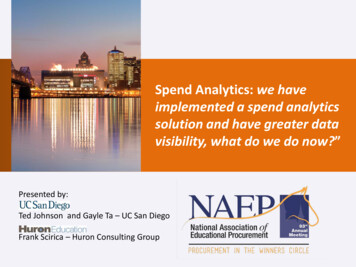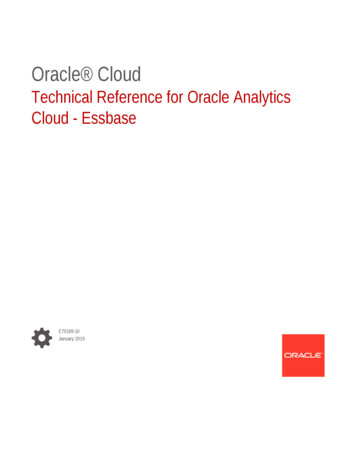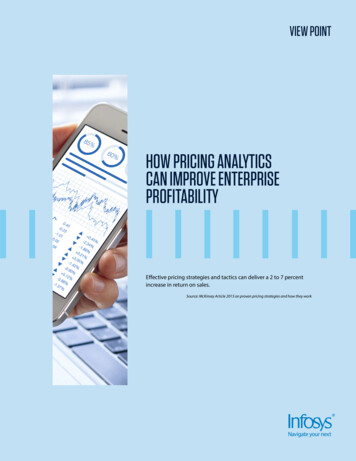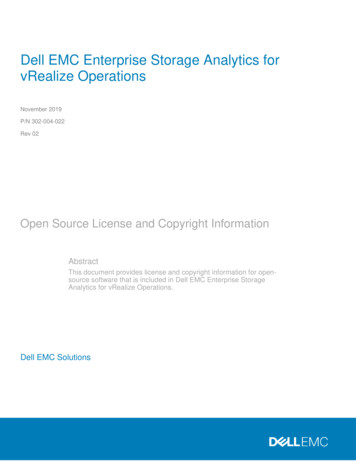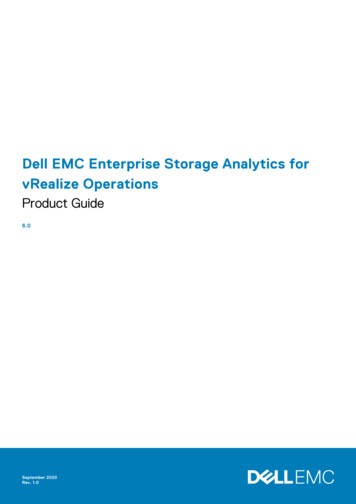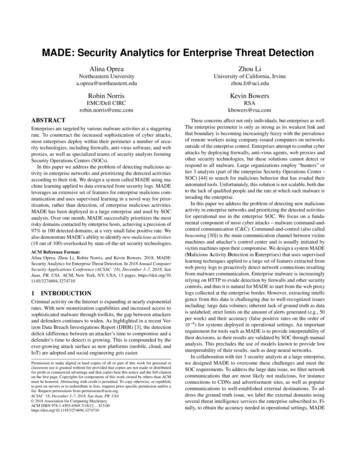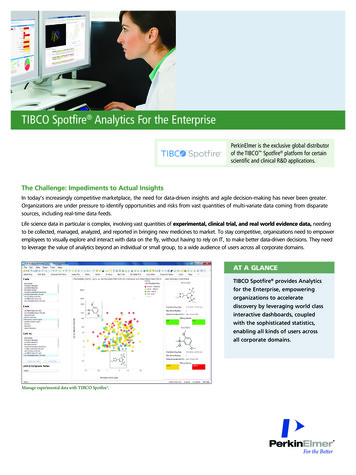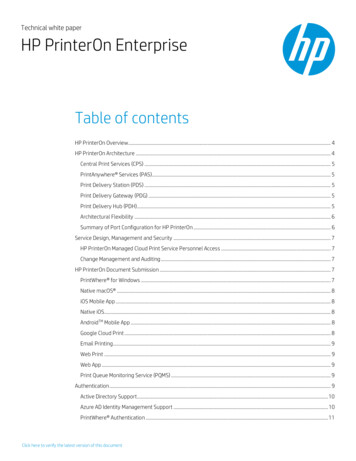
Transcription
Enterprise Analytics:A technical guide to the architectureof the industry’s leadingenterprise analytics platform.
TABLE OF CONTENTSOVERVIEW4Opportunity and growing need5Requirements for an ideal enterprise BI deployment6Welcome to MicroStrategy9Foundations of the MicroStrategy Secure Enterprise Platform10MicroStrategy capabilities11Enterprise reports11Dashboards12Self-service data discovery12Heterogeneous big data access12Scalable and personalized distribution13Information-driven mobile applications13MicroStrategy Cloud13Next-generation security14Sophisticated application development, administration and distribution14MICROSTRATEGY PLATFORM ARCHITECTURE15Unified Platform for Enterprise Analytics, Mobility and Security16Enterprise analytics architectureEnterprise assets1819Relational databases (RDBMS)20MDX and OLAP21Big data21Local files23Cloud data24Enterprise resource planning (ERP)26Cloud apps27Statistical libraries28External charting and graphing libraries29Maps30Media31Directory services33Physical access control systems (PACS)34Enterprise mobility management (EMM)35Tools36Key benefits36Data enrichment37Data model38Analytical39Report development40Visualizations41Custom applications42
Testing43User 47Installation48Translation49Metadata repository50Key ns71Services73Key al78Distribution79Alerting80Security81Physical access82Functionality82Access requirements82Workforce analysis82Logical access84Localization85Clients85Key benefits85Desktop for Mac and Windows86Mobile86Web88Microsoft Office89Client SDK90Usher Professional91Usher Security92Deployment options93On-Premises (Secure Enterprise)93Cloud (MicroStrategy Cloud)94PERIODIC TABLE OF THE MICROSTRATEGY PLATFORM95MICROSTRATEGY ARCHITECTURE DIAGRAM95Index96
OverviewSince 1989, MicroStrategy has helped organizations of all sizes tacklethe hardest problems in business intelligence. The MicroStrategyplatform delivers market-leading user interactivity, with greatresponse times, against the world’s largest databases. Today,MicroStrategy technology supports mission-critical analytics, mobility,and security applications across every role in every industry.MicroStrategy has invested heavily to build a platform thatallows organization to capitalize on major trends, including: agileself-service, big data, mobility, security, and cloud computing.Our engineers have worked tirelessly to create an analyticsplatform that is both enterprise-ready and easy to use.This technical guide will provide an overview of the MicroStrategySecure Enterprise platform and its features, and will cover the basiccomponents of the business intelligence architecture. In this guide, youwill learn about the products that make up the MicroStrategy SecureEnterprise platform and see examples of MicroStrategy features thatcan be used to help you meet specific business requirements. Theguide will also describe key MicroStrategy reporting terminology.
OPPORTUNITYOpportunity and growing needToday’s digitally-powered global economy is characterized by shrinkingmargins, an ever-accelerating pace of change, and relentless competition.In this environment, companies can only thrive by leveraging enterpriseanalytics to inject data-driven speed, efficiency, and insight into all aspectsof their business. With timely, accurate, and relevant information at theirfingertips, employees at all levels can make better decisions, quickly solveproblems, and stay aligned with business objectives. An organization witha proper enterprise analytics platform can eliminate waste and inefficiencyfrom its operations and achieve a powerful competitive advantage.Enterprise analytics systems have become essential operational resourcesfor businesses, so the platforms that power these systems must havethe same architectural and managerial sophistication expected of othermission-critical enterprise systems. While analytical speed is paramount,a true enterprise-grade solution delivers performance at scale as part ofa living architecture – one ready to accommodate unpredictable futurerequirements without hitting architectural or functional dead ends. A trueenterprise-grade platform must have the inherent scalability and functionalextensibility to absorb order-of-magnitude growth without negativelyimpacting performance, administration, security, or cost of ownership.microstrategy.com 5
Enterprise AnalyticsRequirements for an ideal enterprise BI deploymentBefore your company commits to an analytics platform, be sure to confirm that it delivers the following architectural1and functional capabilities required for a successful and sustainable enterprise deployment.Architectural efficiencyA true enterprise BI platform must have a highly efficient core architecture that is free of bottlenecks and redundancy.The architecture must anticipate order-of-magnitude growth across all dimensions—data volume, number ofusers, reporting load, etc. It needs to be able to scale gracefully, without degrading performance, complicatingadministration, or driving up costs.Any architecture with duplicative or redundant metadata, data structures, or processes has inherent inefficiencies thatwill ultimately cripple organizational growth. These architectural failings make the analytics environment difficult to2manage and costly to maintain.High performanceA true enterprise BI platform must deliver exceptional performance so users experience speed-of-thought reporting,regardless of data volume, report size, or other variables. The platform should leverage sophisticated query, caching,and computing techniques to ensure every internal process is completed with maximum speed and efficiency.A platform that fails to maintain high performance in the face of increasing data volume will gradually erode your3business by impeding internal productivity and frustrating users.Incremental growth and feature extensibilityA true enterprise BI platform must be able to adapt to evolving business requirements, allowing organizations toincrementally and seamlessly expand the scope and functionality of their BI implementations. The platform shouldbe modular, with plug-and-play elements that can bring new functionality to pre-existing components and build onexisting content so that no rework is required.An architecture that cannot expand organically will eventually become a dead end for your organization, forcing you4to give up on desired functionality or invest in costly rework.Complete access to the entire data ecosystemA true enterprise BI platform must give users access to a wide variety of data, while ensuring the reliability andconsistency of that data. The platform must be able to combine data from a wide array of sources (enterprise, public,structured, and unstructured) into an enterprise-wide logical data model, or shared metadata repository, that servesas a single version of the truth for all enterprise reporting. Users must also be able to fully navigate this data modelwithout encountering internal boundaries.An architecture that generates fragmented data models is set up to fail. Fragmented data models deny users full5access to the complete enterprise data schema and lead to decisions based on incomplete, conflicting information.Sophisticated analytical toolsA true enterprise BI platform must be equipped with powerful analytical tools so IT and business users can quicklyanalyze data, extract meaningful insights, and make better, data-driven decisions. The platform should includeinteractive features that help users sift through massive volumes of data. It should support sophisticated advancedand predictive analytics, so users can mine data for useful insights and make more accurate projections of futurebusiness performance. And users should be able to leverage visual data discovery to quickly spot trends and outliersusing powerful visualizations and geospatial analytics.microstrategy.com 6
Enterprise AnalyticsPlatforms that lack sophisticated analytical tools prevent users from uncovering complex or subtle insights that could6impact their business.Efficient enterprise-wide publishingA true enterprise BI platform allows users to distribute analytical findings throughout the organization, using a widevariety of formats. The distribution process should be highly automated, enabling a user to build a report once andpublish it to thousands of users. Users must have the flexibility to embed reporting into invoices, presentations, or emails,and to package analytics into feature-rich dashboards that can be readily consumed on mobile devices or web browsers.An enterprise-grade solution allows users to personalize report distribution by applying filtering rules that ensurerecipients see only the data that is relevant to them.Without automated publishing features, users are forced to create multiple instances of the same report, an inefficient7process that delays the distribution of critical insights and creates on-going issues with version control.Proactive business monitoringA true enterprise BI platform includes programmable and dynamic features that help an organization run itsbusiness in a data-driven, automated manner. The BI system should serve as the first line of defense for yourbusiness, monitoring KPIs in real time and triggering alerts when critical thresholds are met. It should also supporttransactional, or write-back, capabilities so that employees can instantly take action to pursue opportunities orresolve problems.Without proactive monitoring, organizations can become trapped in a perpetually reactive mode—unable to8respond to issues and problems until they are too big to easily correct and are negatively impacting their business.Self-service data discoveryA true enterprise BI platform does not rely solely on IT for report creation, rather it encourages business users toperform self-service analytics on enterprise data or their own personal datasets. Business analysts should have userfriendly access to the same powerful analytical tools and sophisticated interfaces typically used by developers. Thesolution must include automated data management features so business users can selectively access, blend, andexplore enterprise data on their own—without IT support. The platform must also include governance procedures toensure business users can align personal data with trusted enterprise data while avoiding reporting conflicts.A BI platform that fails to equip business users with a self-service analytics solution will inevitably force users to pursueless reliable point solutions. This creates an environment in which business decisions are made based on inconsistent9or fragmented data.Best-in-class mobile analytical appsA true enterprise BI platform must include a robust mobile component that empowers on-the-go employees.Customer-facing employees, including sales people, store managers, and service personnel, have a direct impact onthe success and perception of their organization. It’s essential to arm these remote employees with analytical toolsthat help maximize their productivity. An ideal platform should be able to package analytical reports and dashboardswithin mobile apps that leverage the native functionality of mobile devices. These mobile apps provide relevant anduseful guidance to employees, and help inform engaging, professional interactions with customers. These apps cango even further in boosting the effectiveness of mobile employees by including transactional capabilities that letusers take immediate action in the field.Platforms that merely make BI reports available through mobile web interfaces are insufficient. They simply cannotdeliver the level of relevant, real-time guidance that native mobile analytics apps can provide employees.microstrategy.com 7
10 Enterprise AnalyticsRobust security architectureEnterprise BI platforms interact directly with your critical business data, so it’s essential that these platforms deliverrobust security at every level of the BI architecture. A true enterprise BI system must be able to: authenticate users,control access to metadata objects, validate users on mobile devices, and encrypt communications across the entireanalytics ecosystem. Administration should be centralized, so that security for all objects and applications can beefficiently and securely implemented from a single location.Given the increasing frequency and scale of data breaches, enterprise security is of paramount concern. Platformsthat lack end-to-end security, or have inefficient workflows for security administration, put your organization’s critical11enterprise data at risk.Efficient, automated administrationA true enterprise BI platform must be simple and efficient to administer. The administrative system should abstractthe complexity of managing a production system and include tools for automating manual tasks, including: life cyclemanagement, data integrity checking, and platform monitoring.Platforms with inefficient, non-unified administrative systems will become more difficult to monitor and manage as a12deployment scales. This leads to poor performance, security vulnerabilities, and an increased total cost of ownership.Rapid development and deploymentA true enterprise BI platform must be designed for speed. The platform should include the right tools and services toallow developers and analysts to rapidly prototype and create new applications. The ideal platform should be able tomeet to the needs of every user across the organization, from IT administrators, to citizen data scientists, to businessusers. The platform should be able to be deployed in both centralized and decentralized scenarios, catering to bothIT-centric and departmental approaches.The platform should also have the architectural flexibility to be deployed on-premises or in the cloud—withoutcompromising functionality, performance, or security. By deploying BI in the cloud, an organization can quickly standup a new environment—allowing for minimal upfront investment and very quick time to value.BI solutions without easy-to-use tools and services and flexible deployment options create significant time and costbarriers for organizations that want to quickly get started with BI.microstrategy.com 8
Enterprise AnalyticsWelcome toMicroStrategyOrganizations have vast quantities of potentially useful data at theirdisposal. For some organizations it resides in Excel, for others in petabytes ofenterprise data that’s spread across multiple systems and data warehouses.Businesses need tools that can help them efficiently analyze this data,uncover new insights, and put information in the hands of their employees.While analytical requirements can vary widely depending on the scale andobjectives of a deployment, embracing a data-driven philosophy helpscompanies make smarter decisions and greatly improve productivity.MicroStrategy Secure Enterprise is the industry’s mostcomprehensive analytics platform. It is a single, cohesive offeringthat empowers both IT professionals and business users to fullyharness the power of data. MicroStrategy is the only platformthat combines enterprise-grade performance, scalability, andsecurity with delightful, easy-to-use interfaces and workflows.microstrategy.com 9
FOUNDATIONSFoundations of the MicroStrategySecure Enterprise PlatformThe key to building a modern enterprise BI platform is unification. Organizationsin the market for an analytics solution are looking for a key set of functionality.They want scalability, performance, and a unified user experience—things thatare just not possible with a set of distributed point solutions.The major difference between applications suited solely for departmentaldeployments and those meant for the enterprise is the ability to growincrementally. Good enterprise-grade technologies care deeply aboutopenness and extensibility, allowing organizations to quickly and easilyincorporate new technologies into their platforms. In addition to this focus onopenness, enterprise-grade solutions need governance to manage the growththat comes with self-service. This is especially important when organizationsneed to deploy applications to thousands of users with unique security profiles.These factors, coupled with the ability to rapidly build applications that delivera consistent experience across all interfaces - web, desktop, and mobile - arewhat make up the foundation of a modern enterprise BI platform.microstrategy.com 10
Enterprise AnalyticsMicroStrategy capabilitiesThe capabilities of the MicroStrategy Secure Enterprise platform focus on the managed delivery of data and keyperformance metrics. Once an organization has created meaningful analytics, it should be able to operationalizethem—effectively aligning the organization behind those numbers to enable better decision-making and elevateperformance across the organization.With MicroStrategy, data from any source can be brought to life. Users can build any type of information application,from banded reports and interactive dashboards to data discovery and sophisticated mobile apps. MicroStrategyoffers a powerful range of analytical capabilities that can scale to satisfy the analytics requirements of any ITprofessional, data analyst, or business user.Enterprise reportsEnterprise reporting is at the heart of a system-of-record business intelligence platform. These reports enableorganizations to put critical insight in the hands of every decision maker. MicroStrategy provides an extensive set oftools for report creation, customization, and distribution, enabling every type of user to access the information theyneed. MicroStrategy supports a wide range of reporting objects. Users can create operational reports, business reportsfor ad-hoc analysis, branded invoices, statements, and more. And because every reporting object shares a commonmetadata layer, users can view and interact with the same reports on their desktop, web browser, tablet, or phone,without any reconfiguration or administrator intervention.microstrategy.com 11
Enterprise AnalyticsWith MicroStrategy, users can slice and dice data using powerful Online Analytical Processing (OLAP) functionality.This enables administrators to deploy a single report to meet the analytical needs of a wide range of users—greatlyreducing the burden of development and administration.DashboardsDashboards are powerful analytical tools that enable users to get real-time updates on business performance.These visual, information-rich applications are designed to provide decision makers with key business metrics andperformance summaries.With MicroStrategy, building powerful dashboards has never been easier. Quickly change formatting and dashboardparameters to tailor the layout and contents of dashboards to meet individual needs. Easily transform visualizationsinto production-ready dashboards without the need to start from a blank canvas.MicroStrategy makes it easy to build powerful, personalized dashboard applications for every employee inyour organization. Maintain uniformity and consistency across web, desktop, tablet, and smartphone, withoutcumbersome redesign. Dashboards can also be easily integrated into existing documents, presentations, andworkbooks using our Microsoft Office client.Self-service data discoveryThe rise of self-service analytics has changed the way that business users interact with data. By giving every useraccess to data discovery functionality, self-service analytics greatly enhances productivity. And with more peopleanalyzing data, opportunities to find value and new insight grow. MicroStrategy extends data discovery by makingit easy to connect to any data source, transform or prepare data for analysis, build dashboards and visualizations, andshare and collaborate with colleagues.MicroStrategy offers enterprise-grade data discovery t
the hardest problems in business intelligence. The MicroStrategy platform delivers market-leading user interactivity, with great response times, against the world’s largest databases. Today, MicroStrategy technology supports mission-critical analytics, m

